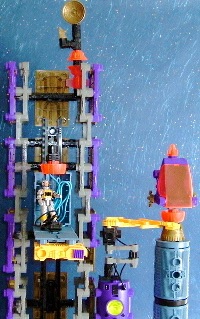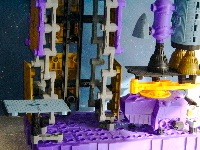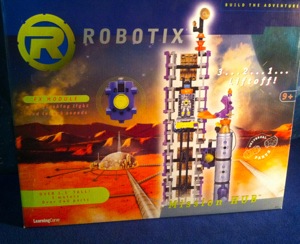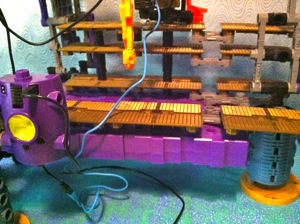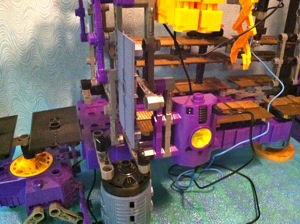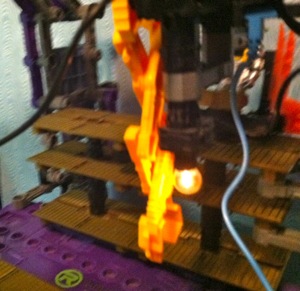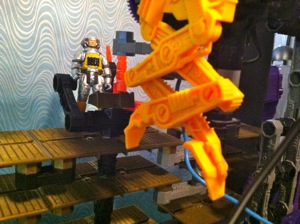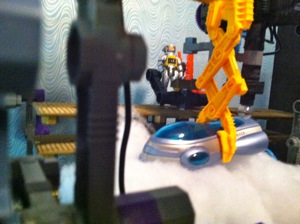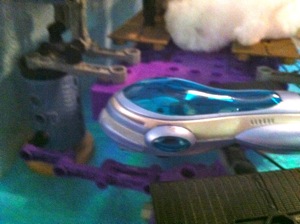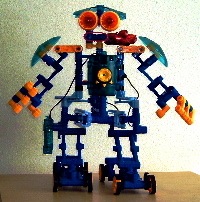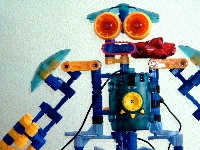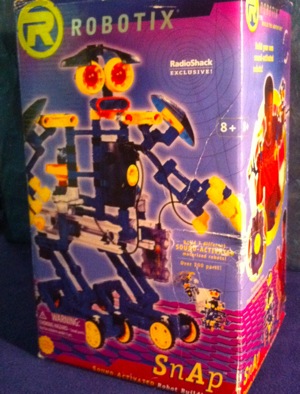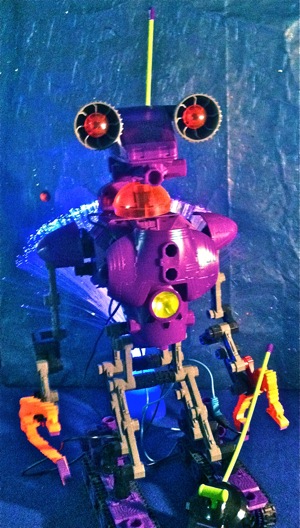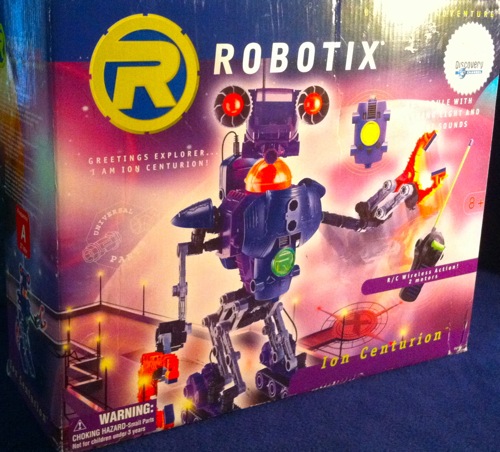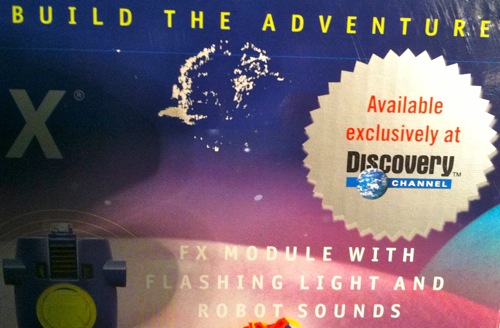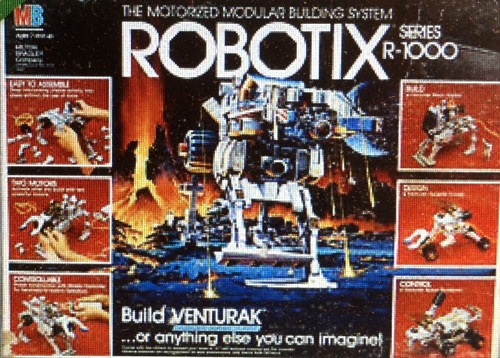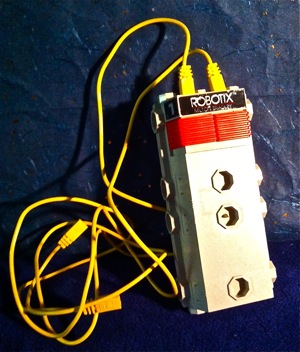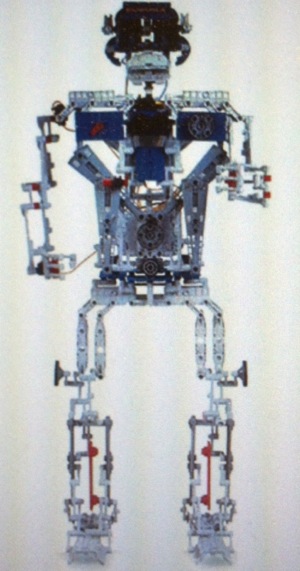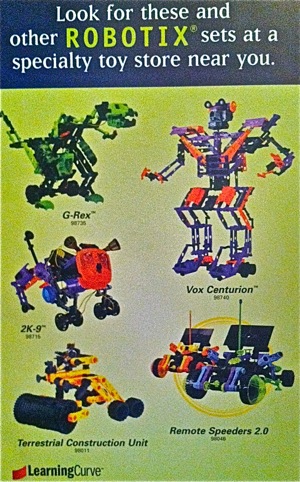|
|
|
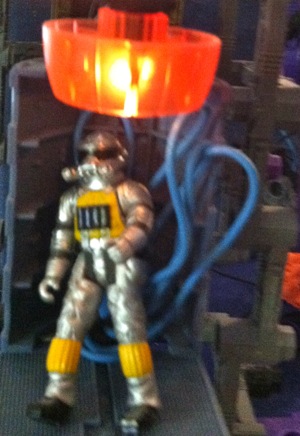

|
|
|
Above:
the amazing
Mission Hub set includes three motors and a sound
and light module.
It's easy to build, has a relatively small
footprint, yet towers over
three feet tall. What do the motors do? One runs
an elevator, which
carries the included figure of Lieutenant Denver
(left). The yellow
controller has a three position switch (purple) to
run the elevator up,
down or off. A light above the elevator also
lights (middle). The
purple sound and light module is also shown in the
left photo.
What do the other two motors do? One runs an arm
(yellow) that sort of
grabs the rocket. The other turns the launch pad
(right). Both of these
seem rather odd uses for the motors, but the
elevator is very well
done, and if you used pieces from this kit to
build your own creations,
you'd have some outstanding motors, sounds, and
lights. This set, which
dates from 2000, is branded "Learning Curve", and
displays their
Robotix logo of an R in a gear.
Each of the sets also builds something else. The
Mission Hub kit above
also builds the Sub Hub below. I thought this
would be an easy to build
afterthought dreamed up so the set could be billed
as a construction
kit, rather than just a Mission Hub kit. The five
minute project turned
into five hours. One thing that made it so
difficult was that many
parts look alike in the construction plans, and
it's not very clear how
they go together.
Remember that the great thing about the Mission
Hub is the motorized
vertical elevator. Here it becomes a horizontal
traveling crane to
position and launch a sub. It's still the best
part of the set. The
countdown voice is the same (the purple module),
so you launch the sub.
The second motor operates a claw that can move up
and down to grab the
sub. But it can't pick up the sub because the claw
opens as it lifts.
The third motor is put to better use than in the
Mission Hub, however,
as a rotating launching platform.
Below, top row, left: The Sub Hub built. Countdown
module shown on left.
Below, top row, middle: Black rotating launch
platform shown on third
motor (purple) at left.
Below, top row, right: Lamp lights as claw travels
on horizontal
elevator. Most of the gold platform pieces are
just for looks.
Below, bottom row, left: Claw opens as it raises.
Astronaut LT Denver
is now an aquanaut.
Below, bottom row, middle: The directions build a
giant sub out of
random Robotix parts. This isn't it. This is a
tiny hybernaculum
chamber that came with the Will Robinson figure
released with the Lost
in Space movie in 1988 (see Lost in Space
section). But we think it
looks like a sub, and it fits the claw well. The
claw can grasp it, but
not lift it, because the jaws of the claw open
when it raises. We put
layers of fluffy "snow" under the sub to raise it
up, so the claw could
grab it.
Below, bottom row, right: The claw carries the sub
to the launching
platform (motor one), and drops it on the platform
(motor two), which
rotates it into launch postition (motor three).
|
Above:
SnAp Sound
Activated Robot Building Kit was branded as a
Radio Shack Exclusive and
sold in 2001. However, it still displays the
Learning Curve Robotix
logo. Inside was the Learning Curve manual,
which referred to their (no
longer active) web site. The set shown was
labelled for age 8 up, but
the robot shown is harder to build than the
Mission Hub, which was
labelled for age 9 up. The reason is the unclear
directions, a number
of similar, easily-confused parts, and a very
odd design which makes
the robot walk.
There's also an extra piece of paper shoved in the
box of building
hints, apparently meant to address this issue.
However, Radio Shack
sold this kit very inexpensively, making it
impossible to pass up.
Correctly
built,
the robot is quite impressive. His torso is a
sound and light
module. His feet each have a motor and wheels,
and he displays a
walking gait, moving one foot and then the
other.
|
|
Above:
One of the
most satisfying Robotix kits, the Ion Centurion,
rolls backwards and
forwards on motorized treads, by radio control,
turning in the
backwards mode. He also includes a sound and light
module in his torso.
The box is labeled age 8 and up, but this is one of
the easiest and
most satisfying Robotix kits to build. He stands
about 19 inches high,
with another five inches above that for the antenna.
As shown in the
detail, he was at one time sold exclusively through
DIscovery Channel
stores.
You
don't get many
parts in this kit. But random Robotix parts of all
eras (and colors)
are plentiful on E-Bay and used on Amazon, as well
as at garage sales,
and you could use the Ion's ready to go
motors, tread tracks and
radio control to build your own designs.
|
|
|
|

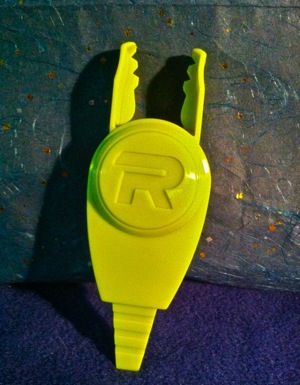
|
Above:
Milton Bradley
invented (or branded) Robotix in the mid-eighties.
Early sets were
white with black and sometimes red. They were
advertised as versatile
building sets and were labeled by size, such as
R-1000 (left) up to the
R-5000 Robot Commander set (middle), which built a
robot towering over
five feet high.
A
Robotix cartoon was
created by Sunbow and Marvel Productions. Fifteen
six minute shorts ran
on the 1985 animated show, "Super Sunday", rotating
with other
cartoons, including Inhumanoids. The shorts were
edited together to
create a 90 minute animated feature, "Robotix: The
Movie" (right).
Above
bottom left: A
two switch battery box/ controller labelled "Milton
Bradley". There
were also five switch controllers and a radio
control model.
Above
bottom
right: Robotix pieces can be difficult to
disassemble and, while
sturdily built, can break if twisted. This
disassmbly tool, here
branded with the Learning Curve Robotix logo, and in
LC flourescent
green, was included in some sets.
|
|
|
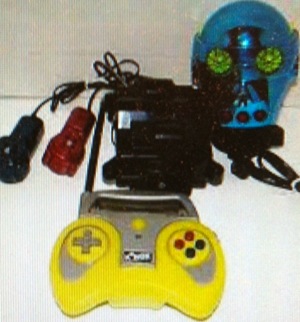
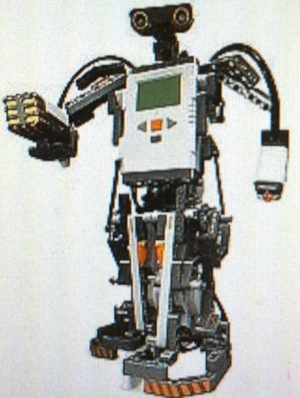
|
|
Above:
a flyer
included in some sets showed an array of amazing
Learning Curve sets.
"Specialty toy stores" often specialized in toys for
girls. Robotix
provided a line for boys, although many girls also
enjoyed and built
the sets. Boys' toys are conspicuous in such stores by
their absence.
K'nex
also made
robotics sets around the same time (top right). Shown
is their
equivalent of the sound and light and radio control
modules. The
problem with K'nex sets is that the robots don't
really have a body.
They look too skeletal, despite the fact that some of
the electronics
were more sophisticated than those in Robotix sets.
Robotix felt and
looked more solid.
Bottom
right: Lego Next robot kits
are often used in FIRST robotics competitions.
Learning Curve developed
teachers' manuals and educational kits allowing
Robotix sets to be used
in schools for STEM (Science, Technology,
Engineering, and Math)
courses.
So now that the Robotix trademark is held by
roboticsandthings.com, how
do things stand? A glance at the R&T web site
reveals a "complete
library of Robotix parts". However, they are all the
white/ black/ red/
gray parts from the Milton Bradley era. They do sell
complete kits. In
2014, the Mission Hub was priced at $174.99, and the
Ion Centurion at
$169.99. Robot Commander is $399.99.
However, the Learning Curve era, (brightly colored)
kits carry this
disclaimer: "In order to give our consumer customers
and commercial
clients the very best Robotix value and keep our
shipping costs from
rising, this item will only be available in a bulk
parts bag with the
exact same parts reproduced." If I had to hazard a
guess, I'd say this
means they don't have the Learning Curve boxes or
can't use them
because of copyright reasons. Since the Robot
Commander dates from the
MB era, he carries no such disclaimer.
Anyone interested in exploring the wonderful Robotix
sets need not
despair. There are twenty years of excellent sets
from both the MB and
LC eras widely and inexpensively available on E-Bay,
used on Amazon, at
garage sales, and elsewhere, as well as oodles of
random parts to build
these or your own creations.
|
|


